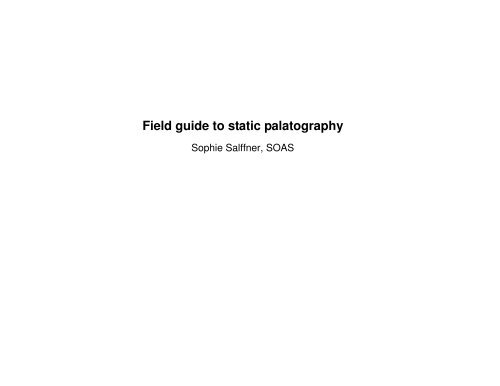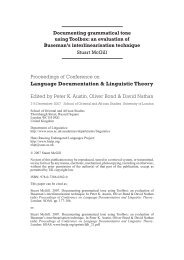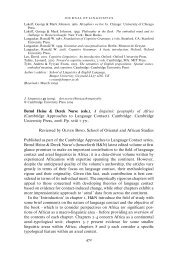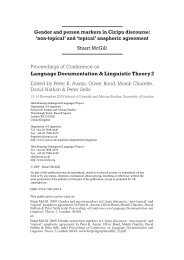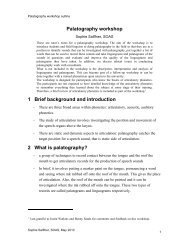Field guide to static palatography
Field guide to static palatography
Field guide to static palatography
Create successful ePaper yourself
Turn your PDF publications into a flip-book with our unique Google optimized e-Paper software.
<strong>Field</strong> <strong>guide</strong> <strong>to</strong> <strong>static</strong> pala<strong>to</strong>graphy<br />
Sophie Salffner, SOAS
Preface<br />
This field <strong>guide</strong> introduces you <strong>to</strong> some of the basics of doing <strong>static</strong> pala<strong>to</strong>graphy in the field.<br />
As a field <strong>guide</strong>, it is not meant <strong>to</strong> replace a course in phonetics or in pala<strong>to</strong>graphy, it does not<br />
cover interpreting pala<strong>to</strong>graphic records and it does not cover how <strong>to</strong> take casts of the palate.<br />
Rather, it is meant <strong>to</strong> jog your memory and <strong>guide</strong> you through the main steps in taking<br />
pala<strong>to</strong>graphic records in the field.<br />
1
Static pala<strong>to</strong>graphy kit<br />
This kit contains<br />
• five intra-oral mirrors<br />
• five brushes<br />
• charcoal powder capsules<br />
• oil bottle<br />
• antiseptic spray<br />
• field <strong>guide</strong><br />
• bag<br />
You still need<br />
• digital pho<strong>to</strong> or video camera and tripod<br />
• possibly an extra source of light<br />
• vegetable oil<br />
• pineapple, fruit juice, juice drink or similar<br />
• tissues and cloths for cleaning up<br />
• cloths and <strong>to</strong>wels for covering the clothes<br />
• detergent for washing the equipment<br />
2
Basics<br />
Pala<strong>to</strong>graphy allows you <strong>to</strong> investigate the place of articulation of consonants that are produced<br />
with a part of the <strong>to</strong>ngue and the manner of articulation for consonants whose pronunciations<br />
involves contact of the <strong>to</strong>ngue with the teeth or the roof of the mouth.<br />
For linguograms, the roof of the mouth is painted so that the paint rubs off on<strong>to</strong> parts of the<br />
<strong>to</strong>ngue. For pala<strong>to</strong>grams, the <strong>to</strong>ngue itself is painted so that the paint is transferred <strong>to</strong> the <strong>to</strong>p of<br />
the mouth.<br />
Records of linguograms can be taken just by poking the <strong>to</strong>ngue out. To take pho<strong>to</strong>s of<br />
pala<strong>to</strong>grams, a small mirror is inserted in<strong>to</strong> the mouth and a pho<strong>to</strong> of the reflection in the mirror<br />
is taken.<br />
3
Deciding what words <strong>to</strong> use<br />
A good word list is fairly short. A good test word<br />
• has the consonant you want <strong>to</strong> investigate<br />
• has only labial and glottal consonants and vowels as other sounds<br />
• has similar other sounds for words that you want <strong>to</strong> compare, ideally they are minimal pairs<br />
• does not include high vowels, i.e. [ i ] and [ u ]<br />
• is a common word that the speakers are familiar with<br />
Good words for looking at alveolars for a non-rhotic speaker of English would be better, borrow,<br />
hollow, saw, buzzer. Words that would not be so good are peel because of the contact of the<br />
sides of the <strong>to</strong>ngue that you would expect or last because the [ t ] would print over the [ s ].<br />
4
Making pala<strong>to</strong>grams and linguograms<br />
Preparations<br />
• get your equipment <strong>to</strong>gether and set up<br />
o word list, mirrors, paste, brushes, tissues, cloths and <strong>to</strong>wels, water, pineapple<br />
o camera on the tripod<br />
o a chair for the speaker<br />
• prepare the paint<br />
o in separate pots for each speaker<br />
o charcoal powder and oil roughly 1:1<br />
o it shouldn’t drip but it shouldn’t have lumps anymore either<br />
o an “eye” for the right consistency develops with time<br />
5
• practise putting in the mirror <strong>to</strong> take records of the palate<br />
o head tilted back, wide open mouth<br />
o mirros at the edge behind the upper teeth<br />
o 45° angle <strong>to</strong> the plane of the upper teeth so that all teeth from the front teeth <strong>to</strong> the<br />
last molars can be seen very well<br />
o as little breathing through the mouth as possible <strong>to</strong> avoid fogging the mirror<br />
• practise taking records the <strong>to</strong>ngue<br />
o let <strong>to</strong>ngue rest on the lower lip for a while<br />
o move it right, left and up <strong>to</strong> show sides and underneath of the <strong>to</strong>ngue<br />
• shoot test films and test pho<strong>to</strong>s without the paint<br />
• take a pho<strong>to</strong> of the palate of each participant for reference<br />
6
Recording tips<br />
It’s best <strong>to</strong> start with linguograms, i.e. with painting the palate <strong>to</strong> look at the part of the <strong>to</strong>ngue<br />
that is involved in the pronunciation. That’s because it may be that after a few pala<strong>to</strong>grams the<br />
<strong>to</strong>ngue doesn’t get very clean anymore and there simply isn’t enough contrast for you <strong>to</strong> see<br />
anything.<br />
If you are recording with a video camera, it is best <strong>to</strong> just start recording and let the camera run,<br />
that way you don’t miss any words and don’t have <strong>to</strong> wait or worry. If you take pho<strong>to</strong>s with a still<br />
camera, be ready <strong>to</strong> take pho<strong>to</strong>s the moment the speaker finished pronouncing the word and get<br />
a number of shots from all angles of the <strong>to</strong>ngue.<br />
If you can, let one person do the recording and note keeping and one person do the instructing,<br />
painting and cleaning.<br />
For each pho<strong>to</strong> you take, write down the test word and the speaker.<br />
7
Linguograms<br />
• let the speaker tilt their head back and rest it somewhere<br />
• paint the roof of the mouth quickly, as far back as necessary<br />
• be careful, some speakers have very ticklish palates<br />
• let the speaker pronounce the test word once<br />
• the speaker must not swallow or do anything else with their <strong>to</strong>ngue<br />
• let the speaker rest <strong>to</strong>ngue rest on the lower lip and take pho<strong>to</strong>s, then let the speaker<br />
move the <strong>to</strong>ngue around and raise it <strong>to</strong> show the sides and underneath and take pho<strong>to</strong>s<br />
• write down the word you recorded, the speaker and the file name<br />
• let the speaker clean up by eating a chunk of pineapple<br />
8
Pala<strong>to</strong>grams<br />
• pad the <strong>to</strong>ngue dry with kitchen <strong>to</strong>wel or a cloth<br />
• apply the paste quickly, as far back as necessary including the sides and underneath the<br />
tip of the <strong>to</strong>ngue for some sounds such as retroflexes<br />
• let the speaker pronounce the test word once<br />
• the speaker must not swallow or do anything else with their <strong>to</strong>ngue<br />
• let the speaker insert the mirror at the edge behind the upper teeth at a 45° angle<br />
• the speaker must avoid breathing through the mouth so as not <strong>to</strong> fog the mirror<br />
• take pho<strong>to</strong>s of the reflection in the mirror, using additional lighting if necessary<br />
• write down the word you recorded, the speaker and the file name<br />
• let the speaker clean up by eating a chunk of pineapple<br />
9
Potential problems<br />
• Speaking with your mouth painted is very strange and the first few pala<strong>to</strong>grams are likely<br />
<strong>to</strong> go wrong. The consultant can practise saying the word in isolation until he or she feels<br />
comfortable and then have the <strong>to</strong>ngue painted <strong>to</strong> say the word. Another way is <strong>to</strong> think of<br />
what the word means and then say is rather that being overly worried about the<br />
pronunciation.<br />
• The inside of the mouth is dark. A flashlight may give enough light but especially if you are<br />
recording with a video camera you may need an extra source of light.<br />
• Getting the angle of the mirror right and opening the mouth far enough <strong>to</strong> get a full view of<br />
the palate until the last molars may take some practice. In Figure 1, the mouth is not open<br />
far enough and the angle is wrong so that we cannot tell if the sound produced here is [ l ]<br />
10
or [ t ] because we cannot see if there is contact at the last molars. In Figure 2, the angle is<br />
wrong so that we cannot see the front teeth.<br />
• Also, the consultants may be covering the mirror with their hands. For example in Figure 2,<br />
the fingers cover part of the imprint on the palate.<br />
Figure 1 Figure 2<br />
11
Cleaning up<br />
• consultants:<br />
• mirror<br />
• brushes<br />
o chew pineapple, rinse with water, mop up with cloths<br />
o wash with hot soapy water<br />
o spray with disinfectant spray and let it sit until dry<br />
o rinse off the disinfectant with hot water and let dry<br />
o wash with hot soapy water until no more charcoal comes out<br />
o pour disinfectant spray in<strong>to</strong> a cup and soak the brushes in there, let sit<br />
o rinse off the disinfectant with hot water and let dry completely<br />
o OR give away and use a new brush for each individual<br />
12
Ethical considerations and involving consultants<br />
• wait until you have established a good working relationship with the consultants<br />
• don’t put anyone under pressure<br />
• observe, learn and take culture-specific cues from how people<br />
o prepare food and deal with and react <strong>to</strong> body liquids such as saliva<br />
o <strong>to</strong>uch each other, in particular around the head and in the face<br />
o use their left and right hand, especially if you are left-handed<br />
o if you are not sure, use a new brush for each participant<br />
• explain what you are doing, show on yourself and let people try for themselves<br />
• let people paint their own <strong>to</strong>ngues and insert the mirrors themselves<br />
• show the results, i.e. the pho<strong>to</strong>s, <strong>to</strong> the speakers immediately<br />
• appeal <strong>to</strong> people’s sense of fun: handprints, face painting, …<br />
13
Selected reading<br />
Overview Gibbon, Fiona and Katerina Nicolaidis. 1999. Pala<strong>to</strong>graphy. In Coarticulation:<br />
Theory, Data and Techniques. William J. Hardcastle and Nigel Hewlitt (eds). Cambridge:<br />
Cambridge University Press. 229-245.<br />
<strong>Field</strong> manuals Anderson, Vic<strong>to</strong>ria. 2008. Static Pala<strong>to</strong>graphy for Language <strong>Field</strong>work.<br />
Language documentation and conservation 2, 1, 1-27. URL:<br />
http://www2.hawaii.edu/~vanderso/LDC.pdf<br />
Ladefoged, Peter. 2003. Phonetic data analysis. An introduction <strong>to</strong> fieldwork and<br />
instrumental techniques. Oxford: Blackwell Publishing.<br />
Interpretation Straka, George. 1965. Album phonétique. Laval: Les Presses de l’Université<br />
Laval.<br />
14


